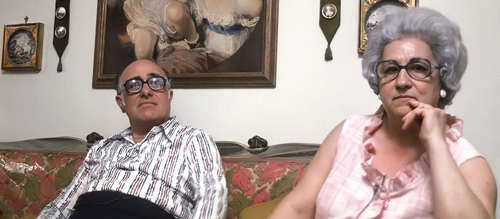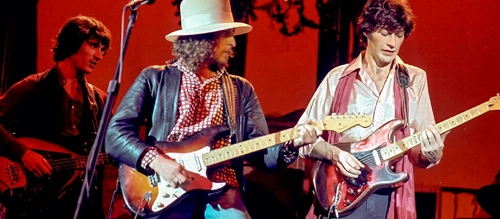5 Unmissable Martin Scorsese Documentaries
The ‘Mount Rushmore’ rating system is an idea etched into modern society. It is an effective way of noting down one’s absolute favourites and greatest of any given thing. When it comes to film directors (a topic that evokes quite the discussion), everyone has their favourites, but for many Martin Scorsese will always have a place on the mountain of the greatest film directors of all time. It’s difficult to argue otherwise.
A prolific filmmaker whose career began in 1967 with Who’s That Knocking at My Door and has covered every decade since, Marty (as his friends call him) is a cinephile of the highest order, and of course an exquisite storyteller whose films have cemented themselves into cinema’s historic and sacred vault of masterpieces. His upbringing as an Italian American in Queens and Little Italy meant that he became accustomed to the crime-riddled streets of New York and the plethora of interesting characters that called that place home; an aspect of his life that is said to have started his love for character examination.
Everyone and their dog knows about Scorsese’s great narrative films – there have been 27 of them altogether: Taxi Driver (1976), Raging Bull (1980), Goodfellas (1990), Casino (1995), The Departed (2006), and The Wolf of Wall Street (2013), being just some of his most iconic releases over the years. But what you might not be so aware of are the great man’s many acclaimed documentaries.
Martin Scorsese’s work as a documentarian has resulted in 17 films over the course of his career. What began with the production of short films in conjunction with the United States Information Agency (USIA) for educational and information purposes, was Marty’s first insight into documentary filmmaking – it wasn’t until Scorsese made the now-iconic Italianamerican in 1974 that his love for the medium began to take shape. Scorsese’s love of people, film, and music, is the basis for many of the great non-fiction offerings he has put his name to; the passions, themes and experiences that define so much of his filmmaking legacy.
We at The Film Magazine would like you to join us in exploring this legacy in our Movie List of 5 Unmissable Martin Scorsese Documentaries.
Follow @thefilmagazine on X (Twitter).
1. Italianamerican (1974)

The 1970s was an important decade for Martin Scorsese. It became the decade that allowed him to cultivate the famous auteur style of filmmaking that forged his career. By the time 1974 came around, Scorsese had already directed Who’s That Knocking at My Door, Boxcar Bertha (1972), and Mean Streets (1973), with the former and the latter taking great inspiration from our first documentary in question.
Italianamerican is an obscure film that explores the relationship between the director and his parents. Starring Catherine and Charles Scorsese, and set in their New York apartment on Elizabeth Street, Martin lays the foundations down for a conversation; a sincere and frank discussion with his parents that covers his upbringing, the importance of family, religion, their Italian heritage, and the difficulties that poor immigrants faced when hoping to gain opportunities in the United States. Even with all these crucial themes being inspected, the most memorable sequence of the film involves Catherine demonstrating how she makes her world-famous (they are to Martin at least) meatballs, a recipe that you can find in the end credits (for all you would be chefs out there).
This is Scorsese’s most intimate and personal documentary. And it comes so early on in his filmmaking journey too. How basic the film appears on the surface is what makes it work, as we follow the Scorseses around their family home and pay homage to a heritage that he is obviously proud of. The talk of religion is an important theme throughout as well; it lays out the ideas that Martin has about Catholicism and its role in his life (he was famously about to pursue priesthood as a vocation before finding his calling). Religion has become one of the most powerful motifs throughout Scorsese’s filmography, with the questions surrounding it becoming the primary structural themes in several of his pictures – think Taxi Driver, Raging Bull, Goodfellas, Silence, and of course, The Last Temptation of Christ.
The importance of Italianamerican is celebrated by the masses as the most important insight into the mind of the famed director – it foreshadows certain subjects and messages that would soon enough become known about Scorsese’s films. Even in its brief 50-minute runtime, we get all we need to know about the origins of the man, as well as an inkling into the style and substance of what his future documentaries might consist of.
Recommended for you: Where to Start with Martin Scorsese
2. The Last Waltz (1978)

Between the years of 1974 and 1978, Martin Scorsese stepped up his filmmaking game. He graced us with the hugely underrated Alice Doesn’t Live Here Anymore (1974) before gifting us with Taxi Driver, arguably his most highly renowned film of all time, before his final film of the decade, New York, New York (1977), a romantic musical forged as a tribute to Scorsese’s hometown of New York and the city’s relationship with Jazz music. It feels almost poetic that Scorsese’s second documentary of his career, The Last Waltz (1978) would be another musical tribute, this time dedicated to Canadian rock band The Band.
Filmed in 1976 during The Band’s farewell show at San Francisco’s Winterland Ballroom, The Last Waltz features concert performances from the band, intermittent song renditions that were shot on a studio soundstage, as well as interviews with the members of The Band conducted by Scorsese himself. The origins of the film began when The Band’s tour manager from 1969 to 1972, Jonathan Taplin (who also produced Mean Streets) proposed that Scorsese should direct the upcoming project while introducing him to Robbie Robertson (lead guitarist for Bob Dylan and member of The Band) as a means of sweetening the deal.
The Last Waltz was marketed as The Band’s “farewell concert appearance” and consisted of dozens of special guests such as Bob Dylan, Neil Young, Joni Mitchell, Van Morrison and Eric Clapton. Scorsese’s love of music, specifically rock music, made this the ideal subject matter to get stuck into. The director’s vision of what he wanted the film’s aesthetic to look like was definitive, and his role with the editors to sift through hours of footage and angles took almost two years of dedication.
The film begins with the title card, “This film should be played loud,” which is exactly how a rockumentary should be experienced. The collection of footage that was gathered and produced offers a unique experience into the backstage goings-on of the music industry, and the interviews that are interspersed during the film are brilliantly insightful and engaging. The Last Waltz is not only one of the most definitive documentaries on Scorsese’s CV, but it has also been dubbed as one of the greatest documentary concert films ever made.

